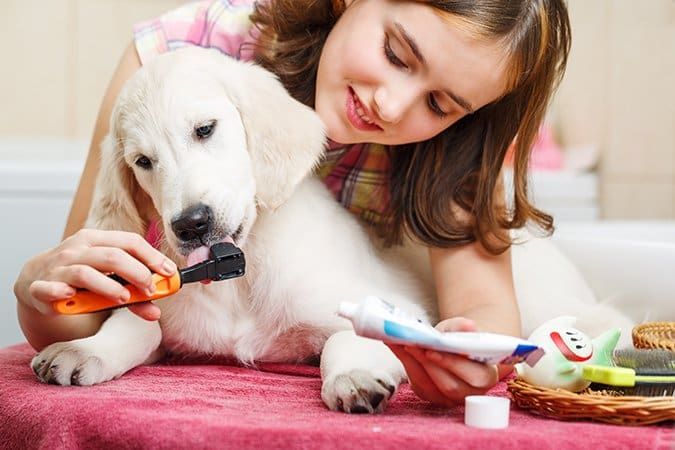When it comes to dental health in humans, it’s simple—combine twice daily toothbrushing with a quick flossing session and a swig of mouthwash, and we’re protecting ourselves against cavities, tooth decay, and other issues. But how many of us take the time to provide the same level of care for our pet’s teeth? Moreover, does the average pet owner even know what to do when it comes to caring for their dogs’ teeth?
According to Scott Linick, DVM, a Fellow of the Academy of Veterinary Dentistry and chairman of the public relations committee of the Foundation for Veterinary Dentistry, brushing your pet’s teeth is the gold standard for home dental care – and it should be done every single day. But, unfortunately, he says that fewer than 10 percent of dog owners brush their pet’s teeth on a regular basis…or at all.
“Home dental care is one of the most important things you can do for your pet next to giving him food and love,” he says. “It’s because 75 to 85 percent of dogs and cats over the age of four experience some degree of dental disease…which has been associated with systemic diseases, such as heart and kidney disease.”
Of course, you can’t just pick up your own tube of human toothpaste and start brushing your dog’s teeth. Just like our dogs don’t have the same dietary requirements as we do, dog toothpaste differs from toothpaste for people in several ways. “It’s important to use a toothpaste made specifically for pets, because human toothpaste contains fluoride and detergents that are not meant to be swallowed,” Dr. Linick says. “No matter how brilliant your dog is, you cannot teach him to rinse.” Additionally, dogs tend to really dislike the taste of mint; you might make the teeth brushing experience even more unpleasant for your dog by using your own toothpaste.
Though there are also toothbrushes designed for pets, according to Laura M. LeVan, DVM, Diplomate of the American Veterinary Dental College, any new, soft-bristled toothbrush can be used for your dog. Look for a brush with a long handle and a brush head that’s small enough to fit inside your dog’s cheek. “And a dog’s toothbrush should be changed at least every three months, or whenever the bristles have worn,” she says.
According to Dr. LeVan, as plaque collects on teeth due to the combination of saliva, food particles, and bacteria, gingivitis will occur in the soft tissues around the teeth. If this plaque remains, it will harden into tartar—and once that happens, your pet’s normal cleansing action of chewing is no longer enough to keep his or her mouth clean. “Plaque builds up on human teeth six to eight hours after brushing, and the same process happens in dogs,” she adds. While the normal immune system in the mouth can neutralize the harmful effects, she notes, periodontal disease can occur. “Often dog owners think this is normal and call it “doggy breath”—but it’s not normal, and it is a sign of disease,” she warns.
When choosing a dog toothpaste, you can start by seeking out the VOHC Accepted seal, though it’s not entirely necessary. “Most pet toothpastes are antibacterial and may have enzymes (lactoperoxidase and glucose oxidase) in them that react with the saliva to become antibacterial,” Dr. LeVan explains. Even if the dog toothpaste you use does not bear the Veterinary Oral Health Council seal, it is probably still effective in ridding your dog’s mouth of plaque and tartar.
After applying the toothpaste, Dr. LeVan advises dog owners to slip the toothbrush underneath the cheek to ensure that the back teeth are brushed; as your dog closes his or her mouth, the outside of the lower teeth brush the inside of the upper teeth, and the tongue action brushes the inside of the lower teeth, so pet owners can concentrate their brushing on the outside (or buccal) surfaces of the teeth.
“Owners should brush their dog’s teeth every day. Although that may sound daunting, it’s actually easier to brush the teeth daily than a few times a week or month—studies have shown that brushing infrequently does not control oral disease, so it’s a waste of time,” she says. “Believe it or not, the whole procedure should only take 30 to 60 seconds. If owners are spending more time than that, they’re making it more complicated than it need be.”
While it’s best to start training your dog to get used to teeth brushing as a puppy, when taking care of an adult dog’s teeth, try to make it as positive of an experience as possible. Many dog toothpastes are chicken or beef flavored; try purchasing a few flavors to see which your dog prefers. If your dog loves the taste of his toothpaste, the chore of toothbrushing might become a lot easier. “It’s important, especially with adult dogs, that you make brushing a positive experience. If you grab your dog in a headlock and start ramming the toothbrush in its mouth, it will be a one-time experience because your dog will run from you,” Dr. Linick says.
Dr. Linick recommends starting slowly, wiping or brushing one or two teeth initially with toothpaste, and giving plenty of praise and treats as you expand your efforts. And if Sparky still refuses? Last resort alternatives to brushing a dog’s teeth exist.”From most effective to least effective, there are pads you can use to wipe the teeth, as well as rinses, chew toys and treats, and water additives that have ingredients to promote oral health,” Dr. Linick concludes. None of these, we will add, are as effective at keeping your dog’s mouth clean as brushing with a toothpaste made for dogs.







Excellent! It’s a pity I didn’t see it before. Having a dog is a big responsibility and we take them for granted, just now I realize they are like us. I had dogs all my life but never any of them, as I recall, got sick and they die of old age.
The one that is sick I got it from the animal shelter, she was 1 yr. old, and after 5 yrs all of sudden got so sick and I got so scared, never seen so much blood liquid stools. I am a senior so I am very scare, I love my dogie, some doctors charge so much money and regular people like me can not afford. Now she doesn’t want to eat. If someone went thru something like please give me some advise about what to give her to eat. Thank you for your help!!!!!!!
It would be helpful if you could write a short article about how to introduce a dog to tooth-brushing. I’m a new dog owner, and there was so much to learn about training, etc, that I haven’t started brushing my dog’s teeth yet. But I’d like to do it, just need a set of instructions for success!